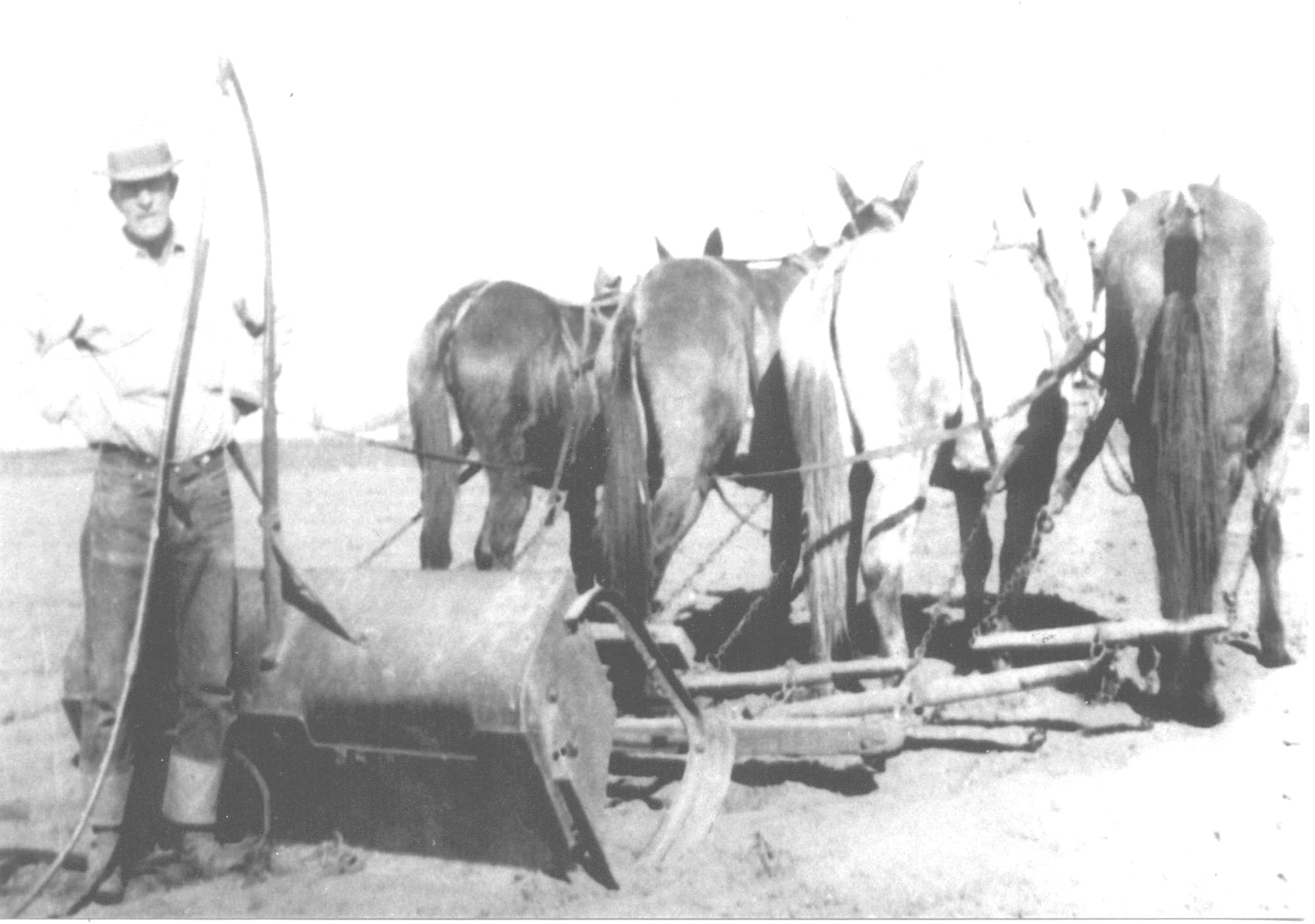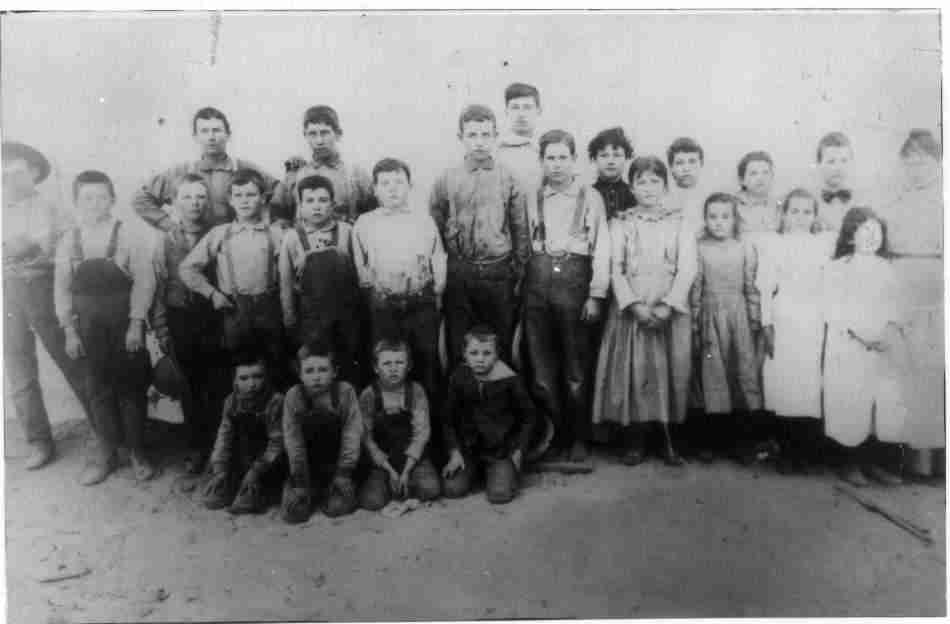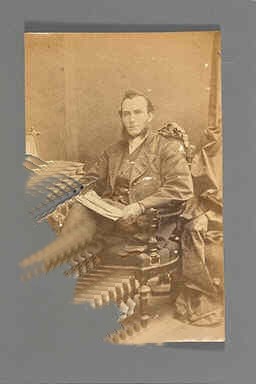Merry Christmas to all my cousins and friends.
A Chairdean Ionmhuinn Mo Chinnidh
|
Vol.17, No.4 Winter,2003 |
1877-THE YEAR OF THE DROUGHT

(Hell no, I wont go!)
The Central Coast of California experienced terrible droughts every seven years. Having some five thousand sheep on hand in the Spring of 1877, one of the worst dry years, Murdock took half of their flock to an area called Arroyo Seco, southeast of Salinas, near Soledad, while Loughlin drove the other half with herders and camp outfits through the San Joaquin Valley and thence over the Sierras into the Bishop Valley in Inyo County, an amazingly long 400 mile trek. The feed in Bishop was plentiful but there was much in the way of hardship. A sudden snowfall or a blizzard would come and panic the sheep and they would try to escape. They would run into gullies smothering each other or coyotes would come in the dawn and stampede them.
Peter Mc Adam may have joined Loughlin for he stated in his homestead application in answer to the question whether he had dwelled continuously on his claim:
“The year 1877 was an exceedingly dry one in California and especially in the county where this land is situated. In the fall of that year the water all dried up and there was no water for people or stock on the land. During that year I took my family to a place about ½ mile from this land where there was water and I took my stock to the mountains to save them: this was necessary as they would have died had they remained there for want of water and feed. I was absent from the place not to exceed two months and returned to be with my family just as the rains came in the Fall of 1877.”
In June of 1877, the local newspaper kept their readers well informed on what was happening to their neighbors and family members.
". . . Many a one who was surely getting rich from the wool of his sheep feels that he is a broken man today. Thousands of sheep and cattle have been driven to the Sierra Nevada Mountains and to Arizona, large numbers being lost on the way from scarcity of feed and water."
Finally, spring came and Loughlin, Michael and Peter with their multinational sheepherders headed home to the Estrella. Many sheep had been lost but the ewes had swelling abdomens and shearing time was on them. Soon lambing time came.
It was estimated that two-thirds of the cattle and sheep from the grazing lands of the county either died or were driven to more favorable pastures.
Today, one hundred years later, the situation has not changed much.(I originally wrote parts of this piece in 1977). The 1976-1977 drought might even surpass the 1877 dry spell. During the earlier drought sheep were selling for ten cents per head, just the value of the hide. Cattle were eight dollars a head. Having saved a good part of their flock, Loughlin and Murdock continued in the sheep business, in time possessing seven thousand head—although when the railroad came through ten years later and the country was being settled rapidly, they found it more profitable to turn to grain and stock.
===============================================================================
UNCLE ALLEN

Mike Dadasovich, grandson of Peter “Allen” Mc Donald, one of my mom's brothers, sent me this. I love getting these old pics so look around in your attic and see if you have some. Here is what Mike said about this:
" This is a picture of my grandfather, Peter "Allen" Mc Donald, with his mule team and his "Fresno Scraper" taken about the time he was helping to dig many irrigation ditches and doing land leveling around Manteca and French Camp. He told me about uncovering Indian burial sites in many locations during his work. I note looking at this pictures his "trademarks", his high rolled cuffs. Some sort of short man syndrome no doubt, buying Levis six inches too long."
++++++++++++++++++++++++++++++++++++++++++++++++++++++++++++++++++++++++++++++
FAMILY HISTORY ON DISKS
The following CDs, are available for only $5.00 each.

" The Mc Donalds from the Bras d' Or to the Estrella" is a book on CD which chronicles our famliy's experiences from Scotland to California and can be viewed on a computer CD drive. It contains 274 pages of narrative and over 50 pictures. This is a compilation of all that I have learned about our ancestors during the past twenty seven years of research.

"Glengarry DVD" plays on most DVD players and computer CD drives. It consists of pictures of Michael Murdock Mc Donalds' Ranch from 1900 to 1940 as narrated by him.
Email me if you want either or both of these CDs.
Phillip's School
''''''''''''''''''''''''''''''''''''''''''''''''''''''''''''''''''''''''''''

The following article was published by the Paso Robles Museum.
In 1894 brothers Loughlin and Murdock McDonald and their cousin Ronald McDonald counted their offspring—26 in all. They realized they had enough children to start a school adjacent to their farm on the Estrella Plains rather than continuing to send their children some distance to the Keyes Canyon or Estrella School. In the spring of that year Oliver Perry and Murdock McDonald appeared before the San Luis Obispo County Board of Supervisors and were given permission to move the Folsom schoolhouse to a location next to Murdock’s property in the settlement of Bern, on the Estrella River Road 12 miles east of San Miguel. (In 1904 the settlement of Bern had established a post office, which existed until 1932.)

They placed the schoolhouse on skids and pulled it down the county roads with their horses, placing it on land donated by Chauncey H. Phillips for whom the school was named. The original deed was dated July 8, 1895.
For most of the early years, the trustees were the three McDonalds and O.A. Perry. Loughlin’s son, Daniel, built a fence around the site and, as there was no well at that time, was paid to tote water daily, probably from the nearby Estrella Creek. Without county or state financial assistance the first year, the school was supported by donations—which mostly ranged from $3 to $5—collected from neighbors and parents. The first teacher, Miss Sallie Findley, was hired for 8 months and received a monthly salary of $55. The following year Miss Allie Kelshaw taught 16 pupils—15 were McDonalds and the other was a Perry.
In the fall of 1897 the trustees made their most expensive purchase: an organ and stool for a total cost of $43.
Nine or 10 Mennonite families settled in Estrella in 1896, and by the end of the century, there were 22 McDonald children and three Mennonite children attending school.
As with other area schoolhouses, Phillips served as the location for community dances. Saturday night dances and socials often lasted until early morning. William “Bill” Norin’s uncle Allen McDonald (see picture above with horses) told him that many times he would get home in the early morning hours just in time to hitch up the horses to plow the fields. Allen also admitted that sometimes he would sneak outside the dance hall to reverse the wheels on someone’s spring wagon. “Those buggies,” he said, “certainly looked strange traveling down the little dusty road in the moonlight with their large wheels up front and their little ones on the rear.”
Due to financial problems, Loughlin McDonald lost everything. He and his family of 14 children moved to Hanford, creating a sizeable drop in enrollment for the 1902-03 school year. The removal of this one family ravaged the student body. There were only six children enrolled on the first day of school. The enrollment continued to be low—in 1910 the total enrollment was seven (one boy and five girls in first grade and one boy in fourth grade).
In a 1915 county Chamber of Commerce publication, Bern was advertised:" Thirteen miles from San Miguel, fourteen miles from Paso Robles, population 20, reached by stage; offers attractions for farming and general stock raising."
The Frank Ernst family rented farm land on the Hillman ranch and lived in an adobe house on the north side of the Estrella River. Hazel (Ernst) Steinbeck, who started first grade at Phillips in 1916, and her brothers Harold and Ellsworth walked approximately 1¾ miles through the river to school, which was on the south side. When the river was flowing, they took off their shoes to ford the river although many times they used stilts to get across.

The children were afraid of the bulls grazing in a pasture that they had to walk through, but they were never attacked.
During recesses, in addition to swinging on a swing that hung from a big oak tree limb in the schoolyard, the children sat on wide boards and skimmed through the dirt and dust down the fairly steep hill behind the schoolhouse. One time Hazel caught her dress under the board and tore it. She was scolded when she arrived home because she only owned three dresses—one for church and two for school.
Hazel noted, “The older children often helped the first and second graders with their learning and the younger children also benefited from being together with the older children and hearing them say their lessons. On rainy days spelling and arithmetic bees were held.” Hazel, at Phillips through sixth grade, also remembered a community picnic near the river on May 1st.
As school-age children grew up and finished their eighth grade there was little reason to keep the Phillips School near the once heavily populated McDonald ranches. Bill Norin remarked that when Mrs. Bertha Truesdale was the teacher in 1919, there was much talk of relocating the schoolhouse, but it was feared that the building couldn’t stand the move. In fact, there was fear that a winter storm would destroy it.
The schoolhouse was eventually moved to Whitley Gardens, 12 miles from Paso Robles and 8 miles from Shandon on Highway 46 East. [What happened to the old schoolhouse?]"
++++++++++++++++++++++++++++++++++++++++++++++++++++++++++++++++++++++++++++++
Brother Ronald
L and M's brother was to me the hero of the family. Early in his life he worked in a mercantile store owned by a Mr Cunard, this may have been a member of the famous Cunard family which owned Cunard Shipline. At a relatively early age he purchased the store and his brothers worked for him. He eventually loaned them money to finance their trip to California. In 1881 he was appointed collector of customs in Sydney, a posistion he held until his death in 1910.
Cheers for Bro Ron. Here is his picture:

+++++++++++++++++++++++++++++++++++++++++++++++++++++++++++++++++++++++++++++